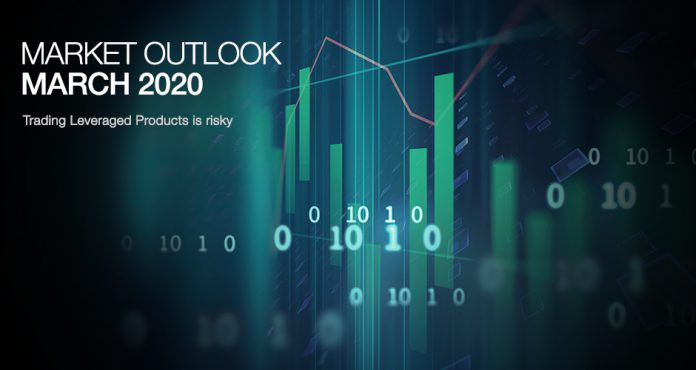CLICK HERE FOR THE .PDF VERSION OF THE OUTLOOK
CURRENCIES
Dollar:The Dollar started off the month quite weak, even though it continues to register as the strongest main currency on the year-to-date, with USDIndex gains of around 2%. The reason behind this was the fact that markets were fully factoring in a 50 bp rate cut by the Fed at its upcoming March 18th meeting, a side effect of which has been recent weakness in the Dollar. Surprisingly however, the Fed cut rates by 50 bp on March 3rd, which had been discounted, albeit coming sooner than expected. Positioning in the Fed funds market fully factors in a follow-up 25 bp easing at the approaching March 18th FOMC meeting, which would wipe out the three quarter-point hikes of 2019. From the economic data perspective, fundamentals on the US economy remain strong without much disruption to the economy yet from Covid-19, even though global and US outlooks for the near-term were mostly for modest growth with the coronavirus and the upcoming presidential election cited as potential risks.
Euro:Developments in the Euro continued to be more positive than expected, supporting the gradual recovery scenario in the Eurozone, but the reports were largely dismissed as backward looking given the looming impact of the coronavirus. The manufacturing sector, however, remains in overall contraction territory, despite the pace of contraction slowing for a second consecutive month while the labor market remained robust. Meanwhile, March started with weak inflation on the 1st, while the ECB meeting on March 12 is expected to join the Fed in adding stimulus to offset the drag on growth projected from the coronavirus. Lastly, given the negative yields and apparent exposure to the coronavirus in the Eurozone coming at a time when German growth is sputtering as demand for its exports dives, and as the US Treasury market remains a top safe haven for global capital, Euro faces a lot of risks. Offsetting this to a degree, will be the generally better performing US economy relative to Europe.
Sterling: February saw a continuation of the Sterling decline on the risk of the UK leaving the post-Brexit transition period at the end of the year without a new trading deal with the EU, and partly as the currency found itself on the list of those vulnerable to a prolonged phase of risk aversion in global markets sell-off, given the reliance on foreign investment to fund the UK’s current account deficit. Given that January and February economic data showed a post-election rebound in economic activity in the UK, Brexit remains a concern, while the BoE meeting is on March 26, with the markets pricing in a 50/50 chance for the central bank to deliver a 25 bp rate cut.
Yen: The Japanese currency was a gainer against the Dollar in February. Trade performance was exceptional, driven in part by markets discounting Fed easing and in part by safe haven demand for the Japanese currency, along with repatriation of overseas capital by Japanese investors as fears mount about the global economic disruption caused by measures being taken to contain the COVID-19 virus. The Japan economy meanwhile contracted -6.3% in Q4, while February’s data continued indicating contraction especially in the manufacturing sector. GDP and trade balance are released on March 8th, CPI on March 18th, the BoJ’s decision on the 19th, Tokyo CPI on the 26th and Industrial Production on the 30th.
Aussie: The Aussie started the month stronger against its US counterpart, following a strong plunge in 2020 to 11-year low areas, which registered it as the weakest of the year out of the main currencies. In general the antipodean crosses are widely seen as barometers of risk appetite in global markets, hence as Aussie is a currency proxy of China, it should be no surprise that it has been underperforming amid the prevailing risk-off carnage from the coronavirus outbreak. The Australian economy is exposed given that Asia accounts for most of the demand for its exports, with the RBA signalling that it is prepared to ease monetary policy further to support the Australian economy, after cutting interest rates by 25 bp on March 3. The RBA cut rates as part of further easing in Australia that had already been on the cards before the virus hit.
Loonie: The Loonie managed to extend its losses against the Dollar in February. The gain partly reflects outperformance in the US Dollar and partly underperformance in the Canadian currency, which has been concomitant with a 3%-plus dive in oil prices. The Canadian currency will likely remain subject to near-term volatility as long as the coronavirus contagion remains in a state of increasing spread. Weak oil prices, along with a relatively soft Canadian economy, partially driven by ongoing railway blockades and prospects for global slowing due to the coronavirus could continue adding pressure on the Canadian Dollar. The BoC delivered a hefty 50 bp cut, following on the heels of the FOMC this month.
COMMODITIES
Commodity prices were crushed further in February amid expectations that global demand would be undercut.
Gold: Gold gained significantly in January thanks to safe haven demand, while February was mixed as Gold futures climbed to a year-best $1,659 by late February from $1,586.71. Gold has continued its upwards trend, but been unable to cross over the 1700 mark yet. The rise in Gold was initially aided by safe haven demand but also by the decrease in the 10-year bond yield. Further aggressive easing from the core central banks could allow Gold to retain its gains.
Oil: Oil continued its downwards trend in February, ending the month around the $45 mark, edging back to nearly $47.00 in early March. Crude Oil is now well below the 8-month high close of $63.27 in early January that was due to escalating US-Iran tensions and later on due to the “epidemic”. However, despite OPEC+ output cuts just yesterday which was nearly triple than expected, Oil prices are expected to remain weak in the medium term as inventories keep rising amid lower oil demand due to the coronavirus outbreak.
INDICES
US: Coronavirus uncertainties finally caught up with equities in the second half of February, sending Wall Street sharply lower into month end. Following the FOMC, the USA30 extended declines to a 12% tumble from its all-time high. The USA100 dropped 12% compared to a record high close. The USA500 contracted 11% versus an all-time high of 3,386.15 on February 19. This was the fastest decline from an all-time high in the index’s history, with the speed beating the Black Monday plunge in October 1987. The Fed’s stimulus measures and hopes for coordinated additional stimulus moves globally helped the Stock markets as this could help the Fed to protect the economy from the coronavirus impact. However, the FOMC’s hefty rate cut may not do much to inoculate the economy from the coronavirus, or impact supply chains. But it does fit in with the asymmetric bias from the Fed amid its concerns over low inflation.
Europe: Stock markets in continental Europe moved in tandem with the US exchanges, as the GER30 and UK100 continued their decline, despite mixed economic data releases, which supported the gradual recovery. The biggest losers ın February were the IBEX35 (Madrid, Spain) and FTMIB (Milan, Italy), as markets reacted negatively to the news that Italy is the European country most impacted by the virus so far with the important tourism sector severely disrupted and public life increasingly restricted.
Japan:On a 1-year basis, JPY225 gains contracted to just 1% (was 11%) as virus fear prompted players to unload Asian equities. The Japanese economy underperformed in Q4 2019. A sales tax increase during the quarter was expected to knock growth lower, but the contraction in total GDP was worse than feared, leaving the economy on a weak footing as the nation and world grapples with the coronavirus outbreak in Q1.
CRYPTOS
Bitcoin ended February reverting more than 50% of this year’s gains, closing at the $8413 mark after significant volatility during the month as it traded in the red in the second half. Given the bullish start to the year for cryptos, along with the observation that Bitcoin gained significantly less than its peers, there is likely to be an increased focus on the alternative coins as a potential area for growth. Particular attention will be paid to Bitcoin cash, Ripple and Stellar.
Following a 2-month high volatility regime, and its peak this year, Bitcoin managed to sustain more than 50% of the crypto’s 1-year value. The current price stands above even the $9000 mark, as the future of Bitcoin appears to be uncertain, given the absence of fundamentals to price its value upon. It is expected that its future will be heavily affected by the halving event taking place in May. The reward halving, during which the number of new bitcoins being issued are cut by 50%, takes place every four years in BTC’s case. Its near term future meanwhile could be affected by both global economic and political uncertainty, as bitcoin has been reacting as both a risk-on and risk-off asset at the same time lately.
BONDS
US10Year:Global bond yields moved sharply lower in February as safe haven demand soared on escalating concern over the coronavirus and the market priced in increasingly aggressive policy responses from central banks. This development caused the US Treasury Note to drop by 0.936% in the wake of the FOMC’s rate cut from 1.53% at the beginning of February. However, if the Fed commits to declining rates further in 2020 more downward pressure should be put on the yield.
*All data and references for the above were obtained from the following sources (unless otherwise specified): Analysis (various articles), Economic Calendar, and the MT4 platform.
Click here to access the HotForex Economic Calendar
Andria Pichidi
Market Analyst
Disclaimer: This material is provided as a general marketing communication for information purposes only and does not constitute an independent investment research. Nothing in this communication contains, or should be considered as containing, an investment advice or an investment recommendation or a solicitation for the purpose of buying or selling of any financial instrument. All information provided is gathered from reputable sources and any information containing an indication of past performance is not a guarantee or reliable indicator of future performance. Users acknowledge that any investment in Leveraged Products is characterized by a certain degree of uncertainty and that any investment of this nature involves a high level of risk for which the users are solely responsible and liable. We assume no liability for any loss arising from any investment made based on the information provided in this communication. This communication must not be reproduced or further distributed without our prior written permission.



















